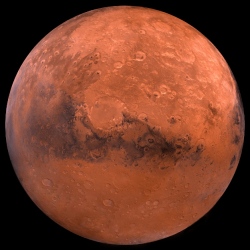
A new study has revealed that during the period in which the red planet’s distinctive valleys supposedly formed, the Martian atmosphere may have already been too depleted to maintain the free-running water that it is believed to have carved out the geological features.
The Martian atmosphere is predominantly made up of carbon dioxide (CO2). It is believed that during the period of valley formation, a much greater amount of the gas was present in Mars’ atmosphere, creating a dense shield that protected the Red Planet against the inhospitable space environment, and preventing water from instantly evaporating.
The new research focused on the largest deposit of carbonate (carbon which had been drawn from the Martian atmosphere and locked into the ground) discovered on the Martian surface, Nili Fossae, bringing together data from numerous missions surveying the Red Planet.
The results of the study cast doubt on the prevailing model of the Martian atmosphere at the time of valley creation, "The biggest carbonate deposit on Mars has at most, twice as much carbon in it as the current Mars atmosphere," states Bethany Ehlmann of the California Institute of Technology and NASA Jet Propulsion Laboratory, Pasadena. "Even if you combined all known carbon reservoirs together, it is still nowhere near enough to sequester the thick atmosphere that has been proposed for the time when there were rivers flowing on the Martian surface."
Prior to the arrival of probes such as NASA’s Mars Reconnaissance Orbiter, scientists believed that many large deposits of carbonate such as that at Nili Fossae would be present on the Martian surface, accounting for the CO2 that had previously, as part of the Red Planet’s atmosphere, allowed liquid water to exist.
But according to the study, there would have to be at least 35 carbonate deposits the size of Nili Fossae close to the Martian surface to support the theory. The researchers state that such an abundance of carbonate is unlikely to exist, as Nili Fossae is roughly the size of the state of Arizona, and that similar deposits would almost certainly have been detected by satellite-based spectrometers.
But if Mars could not maintain free running water in the creation period, just how were the valleys cut into the Martian landscape? "Maybe the atmosphere wasn’t so thick by the time of valley network formation, instead of a Mars that was wet and warm, maybe it was cold and wet with an atmosphere that had already thinned" explains Christopher Edwards of the US Geological Survey in Flagstaff, Arizona.
"How warm would it need to have been for the valleys to form? Not very. In most locations, you could have had snow and ice instead of rain. You just have to nudge above the freezing point to get water to thaw and flow occasionally, and that doesn’t require very much atmosphere."
